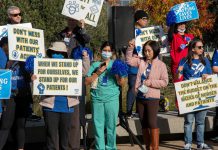Gilroy
– Six years ago, a student started kindergarten at San Ysidro
Elementary School with a life-threatening allergy to latex. The
problem was, San Ysidro’s classrooms contained latex, in everything
from pencil erasers to the glue that held down the carpet.
Gilroy – Six years ago, a student started kindergarten at San Ysidro Elementary School with a life-threatening allergy to latex. The problem was, San Ysidro’s classrooms contained latex, in everything from pencil erasers to the glue that held down the carpet.
For four years, the district had to modify each classroom the student was in, along with the office, library, teacher’s lounge and computer lab. More accommodations, although less drastic, were made as the student moved to another elementary school and to a middle school this fall.
Students and parents have accommodated by changing their habits, too, leaving balloons, stickers, nuts, bananas, peaches and more at home so as not to put her life in danger.
Some of them at Ascencion Solorsano Middle School, which the student now attends, may be breathing a sigh of relief. Her family plans to move out of the district next week.
It’s difficult to know how much Gilroy Unified School District has spent on accommodating the student, as the law requires. District officials could not immediately say because the impacts are far-reaching: A paraprofessional, whose earnings start at $11 an hour, is with her all day at school; students in her class use wipes to wash their hands before entering the room after recess; latex-free classroom and medical supplies must be purchased.
The district’s facilities director has estimated each room at San Ysidro cost several thousand dollars to modify.
Former Antonio Del Buono Principal Pat Midtgaard said that when the student was at that school, buying latex-free physical education equipment was the greatest accommodation expense.
Despite the necessary cost and inconvenience, school officials have said things have gone smoothly and the student has largely been free from danger.
Even at the middle school, where she changes classrooms and comes into contact with many more classmates in a day, the year has started without a hitch.
“It’s almost like you don’t know she’s here,” said Sal Tomasello, principal of Ascencion Solorsano. “Our students have been very cooperative, our staff has been very cooperative.”
Medical trends are indicating that districts, students and parents may be imposed upon more and more as the number life-threatening allergies increases from year to year.
All but one Gilroy public school is now a peanut-free zone. The food is banned where there is one or more student who will stop breathing within minutes of touching or ingesting it. The district’s food service for years has not sold products containing nuts, a move that is becoming more and more necessary.
“We have a number of students in our schools in our district that have severe peanut allergies,” District Nurse Eileen Obata said. “If they touch or eat anything with peanuts, they will go into anaphylactic shock.”
Anaphylactic shock is the most serious allergic reaction and causes a rapid pulse, dizziness, low blood pressure and difficulty breathing.
At Luigi Aprea Elementary School’s back-to-school night Tuesday, parents were handed a letter alerting them of the importance of keeping nuts and nut products away from campus. That school has just joined the list of peanut-free zones.
“We can reduce the amount of potential exposure by not bringing these products to school,” Obata said.
Luigi Aprea also has a student with a severe milk allergy and has banned yogurt contained in squeezable pouches that could potentially open and squirt the dairy product onto a surface or child.
With each exposure, Obata said, allergic reactions become more severe, so prevention is key.
And if parents think a peanut butter sandwich couldn’t be life-threatening, they should think again: Last year, a peanut allergic elementary student went into anaphylactic shock and stopped breathing. After being given epinephrine to relieve the problem and entering a hospital emergency room, he went into shock and stopped breathing a second time. He recovered and is back at school, Obata said.
The district, like the rest of the country, is seeing an increase in the number of allergies that cause anaphylactic shock, the most severe kind of allergy.
As these allergies become more prevalent, more students will be asked to make changes, like leaving a favorite snack at home. It could be a non-issue, as Solorsano parent Kathy Carrera found. At first outraged when she heard her child was asked not to bring bananas to school, as she learned more about the allergy she accepted it, and since school started, the policies haven’t affected her children at all, she said.
Based on what Tomasello has seen, students appear accepting and willing to make changes: The latex allergic student was consulted by the Associated Student Body representatives before they picked out decorations for their first school dance of the year.
When asked, Midtgaard, the former Del Buono principal who is running for school board, said she hadn’t considered a policy at the board level to address the growing number of allergies, but noted that any policy would have to be a broad one to account for all the different types of allergies and needs of students.
In her days as principal, though, she worried that accommodating the latex allergic student would become more and more complex as she progressed through middle and high school. But the schools will make do, she said.
“I don’t really think there was a choice – she was enrolled in our district, so accommodations had to be made,” Midtgaard said.












